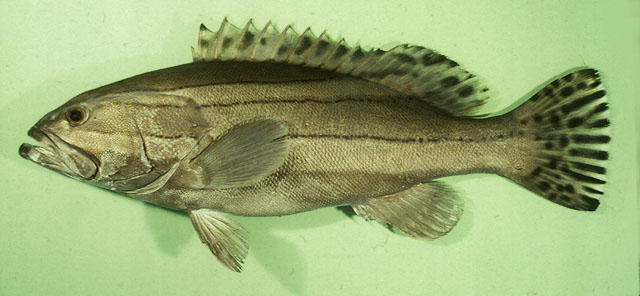| Epinephelidae (Groupers) |
| 137 cm SL (male/unsexed); max.weight: 59 kg |
|
demersal; marine; depth range 20 - 240 m |
| Indo-West Pacific: Red Sea, Persian Gulf, Gulf of Oman, Pakistan, India, Viet Nam, Hong Kong, China, Korea, southern Japan, Taiwan, and northwest Australia. Unknown from the east coast of Africa, islands of the Indian Ocean, Indonesia, Philippines, or New Guinea. |
|
Dorsal spines (total): 11-11; Dorsal soft rays (total): 12-14; Anal spines: 3-3; Anal soft rays: 8-8. Distinguished by the following characteristics: juveniles are lavender-grey or pale brownish, shading to white ventrally; 2 black-edged white longitudinal bands, upper band extending from above the eye to the anterior dorsal-fin rays, and the lower band from below the eye to the lower band from below the eye to the lower caudal-fin rays; black spots and streaks on dorsal and caudal fins; head and body of large adults, uniformly grey; body depth contained 2.9-3.4 times in SL; head length 2.3-2.6 times in SL; convex interorbital area, convex dorsal head profile; angular preopercle, 3-7 distinctly enlarged serrae at angle; distinctly convex upper edge of operculum; subequal anterior and posterior nostrils; maxilla reaches past vertical at rear edge of eye; 2-3 rows of teeth on midlateral part of lower jaw (Ref. 89707). |
| Seems to prefer continental localities; bottoms of low relief. Large individuals are taken on coarse sand or rocky areas, while the smaller ones live on silty-sand and muddy bottom. Also caught throughout the year by long-liners (Ref. 5222). |
|
Least Concern (LC); Date assessed: 21 November 2016 Ref. (130435)
|
| harmless |
Source and more info: www.fishbase.org. For personal, classroom, and other internal use only. Not for publication.

